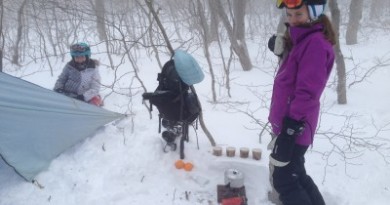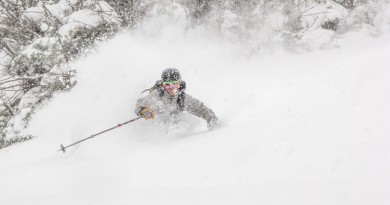Backcountry for Beginners

BOLTON VALLEY — Denny Bowen got his first pair of skis when he was ten years old.
“I was hooked,” he says, describing the days when he and his brother would ski at the country club near where they grew up. “It was so satisfying because we were able to go wherever we wanted.”
Now, at the age of 77, he’s looking to explore new trails, but says getting the best possible introduction to backcountry skiing has been difficult. Five years ago, he made it up the Teardrop Trail on Mount Mansfield’s western flank on Nordic skis. While he was able to make it to the top just fine, the decent, he says, was harrowing.
“That was when I was 72 and young and foolish,” he says. “But I’ve skied enough that I can tell what I need to work on.”
So this past February, Bowen was one of roughly 50 people to take part in the Get Out and Backcountry Ski Festival at Bolton Valley. The event was organized by the Catamount Trail Association (CTA), and provided novice and intermediate telemark skiers with educational clinics on skiing techniques, guided tours to the local network of trails and the backcountry beyond, and demonstrations on types of skis and proper preparation for backcountry travel.
Greg Maino, communications and events director for the CTA, says he understands people’s apprehension before starting a new variety of a sport they may already enjoy.
“Before people go out on a tour or participate in anything else, people can be wary,” he says. “It’s important for them to have baby steps before getting out, so we try and provide stepping-stones all along the way. The goal is to take people from being a never-ever, to giving them the skills and the confidence they need to start exploring on their own.”
Backcountry skiing isn’t an insider’s game anymore and there are plenty of resources available to show you how it’s done and where to go. For beginners, clinics, education centers and guide outfitters offer plenty of opportunities for people looking to learn the basics. Add that to the 300-mile-long Catamount Trail, running the length of Vermont, and more than 1,800 miles of trails maintained by the Vermont Association Of Snow Travelers, and that means plenty of terrain and trails are available to ski.
EXPERIENCED SKIERS, NEW SKIS AND NEW TERRAIN

Jacob Hemmerick, 33, from Colchester, has done some alpine and Nordic skiing, but still classifies himself as a beginner skier. He says making the transition from alpine to telemark skiing was challenging.
“Maintaining balance has been the hardest part because it’s a totally different feel from downhill skiing,” he says. “Doing downhill skiing and then moving over to this is a different balance. It was technically more difficult than I was expecting.”
He and his housemate, Lisa Liotta, became interested in telemark and backcountry skiing after meeting Alan Binnick, a CTA Board Member, at a conference in the fall. Binnick invited them to the southern region of the trail near Wilmington and showed them backcountry travel as well as telemark skiing technique.
Hemmerick says skiing on the Catamount Trail and in other backcountry areas appealed to him because it is accessible as well as affordable. He bought his first pair of backcountry telemark skis this year and after getting an introduction at Bolton Valley, he and Liotta can’t wait to get out more this season.
“We’ve been wanting to go out on the trail even before coming here,” he says. “We’re trying to build the skills so we can go out and stay safe.”
Liotta added that workshops like the one they attended were a good introduction.
“I feel like we have a little bit of confidence to go out on our own and explore a little bit more from what we learned,” she says. “A lot of basics were covered; they were all things that would take a very long time to learn on our own.”
Liotta and Hemmerick aren’t alone. Flora Hurtea, 59, from Milton, has been skiing her entire life and considers herself a “halfway decent” alpine skier.
“Usually with outdoor activities, I just go out and do them, like snowshoeing and alpine skiing,” she says. “It’s what I love to do. I’m not frustrated (with telemark skiing), but making the transition was a very humbling experience for me.”
Despite the learning curve, she says she intends to ski the entire length of the Catamount Trail – all 300 miles – and join the list of “End-to-Enders” on the CTA’s website.
Patty Dunn, 58, from Hinesburg, has taught telemark skiing since 1980. She teaches “Women’s Wednesdays,” a series of telemark clinics for women at Bolton Valley. She says she finds people participate in beginner telemark clinics usually have some background in skiing, usually in alpine or cross-country disciplines. While telemark provides even experienced skiers with many of the familiar movements, the sensation of linking turns in a full telemark position – with heels free and knees dropped – is the most challenging part and the part of the progression that demands the most from her abilities as the instructor. As a result, she says she has to stay positive, be willing to change plans in a moment’s notice and expect students to follow her example.
“I have to rely on the lively spirit and good nature of the skiers,” she says. “The students come with an open attitude and they go with the flow. It’s a laid-back crowd and when you change plans at the last minute, you adapt. That’s a valuable skill you’ll need for backcountry skiing. The conditions are always variable, you never know what you’re going to encounter and you have to be willing to adapt.”
Opportunities to Explore

The Catamount Trail Association holds a series of annual events, including the Trapps to Bolton Tour in March. In the rest of the year, users can access the trail from a backyard or a parking lot for short day tours. For longer trips, skiers can overnight in lean-tos and cabins along the trail or at inns and bed-and-breakfasts.
Exploring the winter landscape on skis goes well beyond sticking to the 300-mile-long trail that the CTA manages. Skiers can use the trail to access their own secret stashes of snow or use the trail to go from town to town. In addition to the Catamount Trail, the Vermont Association of Snow Travelers (VAST) maintains more than 1,800 miles of trails open to all.
“The real goal is to get people out on our trail and all the other trails in Vermont, New Hampshire, New York and wherever else they may be,” says Greg Maino of the CTA. “Giving them the skills and the confidence lets them go out and expand the sport. In the long run, it would be great if those people who developed those skills came back and helped us introduce even more people to the sport.”
Even though he’s a lifelong skier, Bowen says he’s always looking to learn and other people should as well.
“We don’t invest enough in our success,” Bowen says. “Every ski lesson I’ve taken has made me stronger and more confident. If more people would follow through on taking lessons, they would have such a richer experience.”


